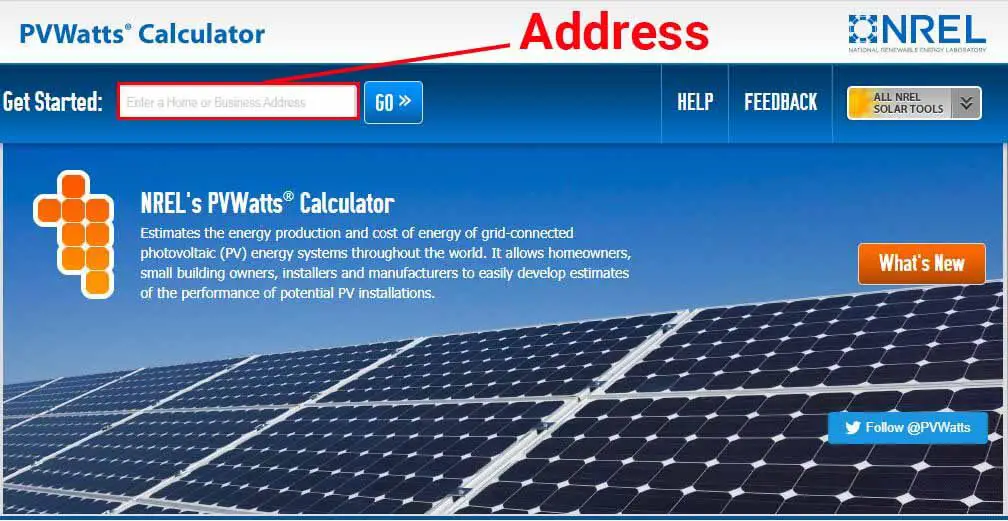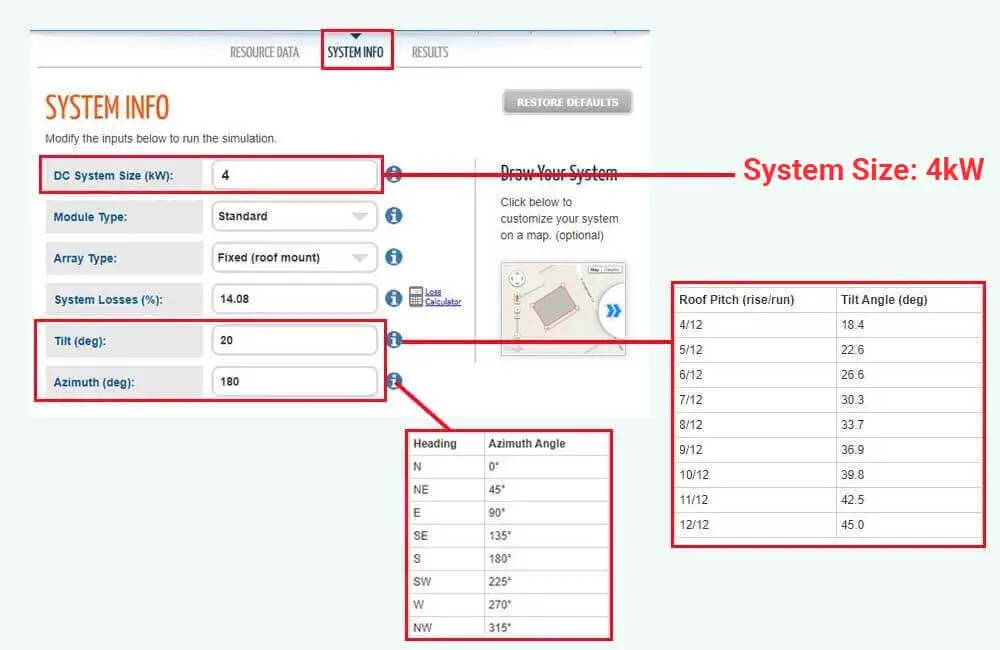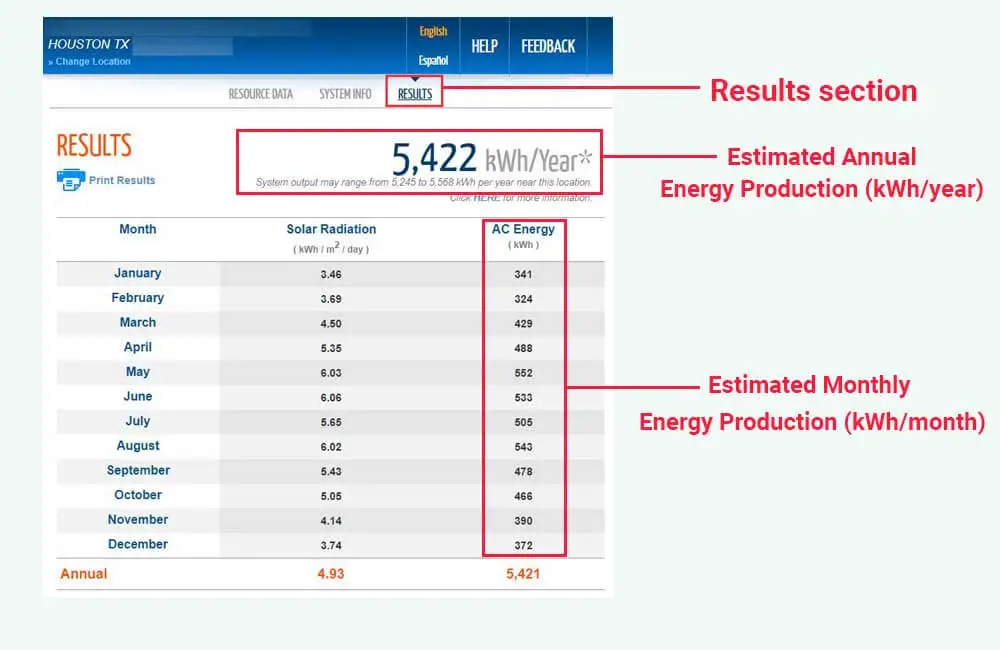Electricity has many measurement units, such as:
- Volts, which measure Electrical Potential, or simply voltage.
- Amps, which measure Electrical Current.
- Watts or kiloWatts, which measure Electrical Power.
- Watt-hours or kiloWatt-hours, which measure Electrical Energy.
The 4kW (4000W) rating of a solar system means that, provided there’s enough direct sunlight, the 4kW solar system can produce 4000W (Watts) or 4kW (kiloWatts) of power, or even more under the right conditions.
Related: How much sunlight do solar panels need?
However, what you pay a utility company to provide is not Electrical Power (in Watts or kiloWatts), what utility companies charge you for, and what really matters at the end of the day, is Electrical Energy (in Watt-hours or kiloWatt-hours).
In this article, I’m going to discuss the energy production of a 4kW system, the factors that influence it, and how you can determine what you should expect from a system of this size.
How much electricity does a 4kw solar system produce?
The exact amount of energy that a 4kW solar system produces on a daily basis is not constant and will fluctuate throughout the year depending on how much sunlight the solar panels get.
However, on average, a 4kW solar system produces around 16 kWh of energy per day, which translates to about 480 kWh of energy per month, or about 5800 kWh of energy per year.
Depending on which time of year it is, the weather, where the system is located, and how it is configured, a 4kW solar system could produce as much as 30 kWh of energy in a single day or as little as 4 kWh.
To give you an idea, the following table compares the average daily energy production (in kWh) of a 4kW solar system, in 12 different states around the U.S., in the months of June and December:
| State | Average Daily Energy Production in June | Average Daily Energy Production in December |
| Arizona | 23 kWh/day | 15.6 kWh/day |
| Texas | 18.8 kWh/day | 12.6 kWh/day |
| Florida | 16.4 kWh/day | 13 kWh/day |
| California | 23.8 kWh/day | 10 kWh/day |
| Massachusetts | 17.2 kWh/day | 7.8 kWh/day |
| Nevada | 24.2 kWh/day | 11 kWh/day |
| Vermont | 16.4 kWh/day | 7 kWh/day |
| Utah | 22.4 kWh/day | 8.8 kWh/day |
| North Carolina | 18 kWh/day | 11 kWh/day |
| New Jersey | 18.4 kWh/day | 8.4 kWh/day |
| New Mexico | 23 kWh/day | 15 kWh/day |
| Oregon | 19.2 kWh/day | 4.8 kWh/day |
Please note that the estimates provided in the table are based on the assumption that the solar panels in the 4kW system are tilted at a 20-degree angle, and are oriented to face south.
Also, it is worth noting that even in the same state, the average daily energy production of a 4kW solar system would differ from city to city.
The good news is, using the PVWatts calculator, a tool made by the National Renewable Energy Laboratory (NREL), you can estimate the average daily energy production of a 4kW solar system in the particular location in which it is installed.
The PVWatts Calculator is a free tool that uses historical weather data to estimate the annual and monthly energy production of a system based on:
- Its size in kW (kiloWatts rating)
- Its location
- The type of panels used in the system
- The efficiency of the system
- The elevation of the solar panels in the system (their tilt angle)
- The direction that the solar system is facing
And you can easily access these annual and monthly energy production estimates by following these steps:
Step 1: Submit the location of the system
Click here, and submit your address or the location of the 4kW system to the PVWatts Calculator.

Step 2: Submit system details
Once you’ve submitted a location to the calculator, the next step is to go to the “System Info” tab of the PVWatts Calculator.

In the “System Info” section of the tool, you’ll find 6 inputs that you can modify. I recommend you leave the Module Type, Array Type, and System Losses inputs to their default value, and modify the following inputs:
DC System Size (kW):
In this field, enter the power rating of the system. Since the system is rated at 4kW in our case, make sure the DC System Size is set to 4kW.
Tilt (deg):
In this field, enter the tilt angle (elevation) of the solar panels.
The angle at which the solar panels are going to be tilted will have a direct impact on the amount of sunlight the system receives, and therefore, the amount of energy the system stands to produce. Make sure to enter the correct angle to get accurate estimates.
If your solar panels are going to be installed on the roof, you can click on the information icon on the right side of the input field to see the degree angle equivalent to your roof slope. For example, a 4/12 roof pitch is equivalent to an 18.4-degree angle.
If you don’t exactly know the roof pitch of the roof section used to install the solar panels, you can use apps such as Measure for iOS or Bubble Level for Android to determine the tilt angle of that roof section.
If your solar system is going to be ground-mounted, you can increase and decrease the tilt angle to see which angle results in the highest energy production.
Azimuth (deg):
Azimuth represents the heading or the direction that the solar panels will be facing. For example, a 0-degree Azimuth means that the solar panels are facing North, and a 180-degree Azimuth means that the solar panels are facing South.
The direction your solar panels will be facing will influence the amount of energy they produce. Make sure to enter the correct Azimuth to get accurate estimates.
If you live in the U.S., or north of the equator in general, the solar panels should preferably face South, because that’s the orientation that would result in maximum energy production. In Australia, or locations south of the equator, solar panels should preferably face North.
However, if it’s going to be a roof-mounted system, due to available space or shading, you might not have the option to install the solar panels on a South or North-facing roof section. If you’re not sure which section of your roof is actually usable, I recommend you read this article.
In any case, if you don’t know the exact heading of the roof section on which your 4kW solar system is going to be installed, you can use apps such as Commander Compass Go for iOS or Azimuth Compass for Android to determine the Azimuth angle.
Once you’ve modified the System Size, Tilt, and Azimuth input fields to the correct values, the next and last step is to go to the “Results” tab of the PVWatts Calculator to get your estimates.
Step 3: Get your estimates
To give you an example, I’m going to enter the following details and share the results:
- Address: an address in the city of Houston, Texas.
- DC System Size: 4kW.
- Tilt: I’ll assume the system is roof-mounted with a 5/12 roof pitch, which is equivalent to a tilt angle of 22.6 degrees.
- Azimuth: I’ll assume that the only unshaded roof section available is facing South-West, this equates to an Azimuth of 225 degrees.
In the “Results” tab, the calculator provided the following:

The tool has estimated that a 4kW solar system in our particular location in Houston, TX, tilted at an angle of 22.6 degrees, and facing South-West, would on average produce around 5420 kWh of energy per year.
In the table, you can also see energy production estimates for each month, which you can divide by the number of days in that particular month (28, 30, or 31) to determine the average daily energy production in that specific month.
For example, while the 4kW solar system would only produce about 341 kWh of energy in January, which translates to 11 kWh of energy per day, the 4kW system would produce around 552 kWh of energy in May, which is equivalent to about 17.8 kWh/day.
What will a 4kw solar system run?
As explained above, a 4kW solar system would on average produce about 16 kWh of energy per day, but the question is: is a 4kW system enough to run a home?
For perspective, according to the EIA, the average American household uses 10500 to 11000 kWh of energy per year. This amount of energy translates to about 900 kWh per month or 30 kWh of energy per day.
In other words, a 4kW solar system would only be able to offset about 50% of the energy consumption of the average U.S. household. If you only use around 400-500 kWh of energy per month, depending on your location, a 4kW solar system will likely be able to offset 100% of that energy consumption.
However, keep in mind that for grid-tied systems, the 4kW system doesn’t really have to offset 100% of your energy consumption for it to work.
For example, if you use 800 kWh of energy in a single month, and the 4kW system only manages to produce 400 kWh in that month, your energy bill will still be reduced by 50%.
For off-grid systems, the solar system will also include batteries (more on that below), and it has to be large enough to offset all of your energy consumption.
But, whether or not a 4kW system is enough for your energy requirements will depend on the appliances you plan or running, their energy consumption, and how often or how long you use these appliances.
So, what can you power with a 4kW solar system?
To provide some perspective, the following table shows some common appliances and their hourly energy consumption (kWh/hour):
| Appliance | Average hourly energy consumption (Wh/hour) |
| Refrigerator | 1000 – 2000 Wh/day (50 – 100 Wh/hour) |
| Washing machine | 500 – 1200 Wh/hour |
| Microwave | 600 – 1200 Wh/hour |
| Coffee maker | 150 – 400 Wh/hour |
| TV | 40 – 200 Wh/hours |
| Desktop computer | 100 – 400 Wh/hours |
| Laptop computer | 20 – 100 Wh/hour |
| Window air conditioner (5000 BTU) | 250 – 400 Wh/hour |
| Window Air conditioner (12000 BTU) | 600 – 1000 Wh/hour |
| Central air conditioner (18000 BTU) | 800 – 1500 Wh/hour |
| Central air conditioner (24000 BTU) | 1000 – 1800 Wh/hour |
| LED light bulb | 5 – 20 Wh/hour |
| Incandescent light bulb | 25 – 100 Wh/hour |
Related topics:
How much electricity does an air conditioner use?
To determine if a 4kW is enough for you, take the average daily energy production that we’ve discussed in the first section of this article, and compare it with your daily energy consumption.
But how do you determine your daily energy consumption?
Well, there are multiple ways to estimate your daily energy consumption, but the quickest way to get some estimates is to use our appliance energy calculator.
The calculator allows you to list all your appliances, their power usage, and usage duration and then calculate your total energy consumption based on that.
Learn more about the calculator here.
In any case, if your estimated daily energy consumption is higher than the estimated energy production of the 4kW system, you’ll need a bigger system.
How many panels do I need for a 4kw solar system?
In general, you would need between 10 and 20 solar panels for a 4kW solar system. The exact number of solar panels that you need to make up a 4 kW solar system will depend on the Power rating (Wattage) of the solar panels you plan on using.
For example, if you use 200 Watt solar panels, you’ll need 20 solar panels to make up 4000 Watts (4000W ÷ 200W = 20). If you use 400 Watt solar panels, you’ll need 10 solar panels (4000W ÷ 400W = 10).
How big is a 4kw solar system?
A 4kW solar system would require between 190 and 260 sq. ft. (21 to 24 sq. m.) of roof space depending on how efficient the solar panels are. The more efficient the solar panel used in the 4kW system, the less space will be needed.
For example, let’s say we use these 440W solar panels from LG in our 4kW solar system, which are 22.1% efficient. To make up a 4000 Watts (4kW) solar system, we would need 9 of these solar panels (4000W ÷ 440W = 9.1).
Now, these solar panels would each take up around 21.4 sq. ft. (2 sq. m.) of space. So for the 9 solar panels, we would need around 192.6 sq. ft. or 18 sq. m. of space.
Related:
How many solar panels will fit on my roof?
How many batteries for a 4kw solar system?
As mentioned above, a 4kW solar system will produce around 16 kWh (or 16000 Wh) of energy per day. To be able to store and access that amount of energy, you would need – at least – 14 batteries rated at 12V-100Ah, 7 batteries rated at 24V-100Ah, or 4 batteries rated at 48V-100Ah.
However, to properly size a solar battery bank you would need to consider your daily energy consumption. In addition to that, there are other factors to consider, such as the depth of discharge and days of autonomy.
Read more on this subject here: How to calculate battery capacity for a solar system?


